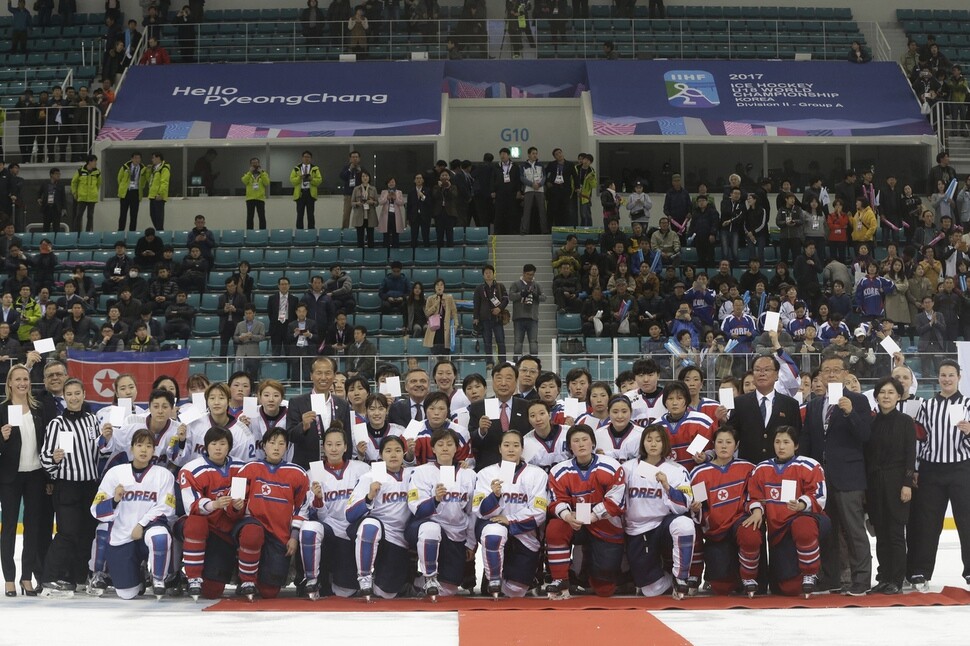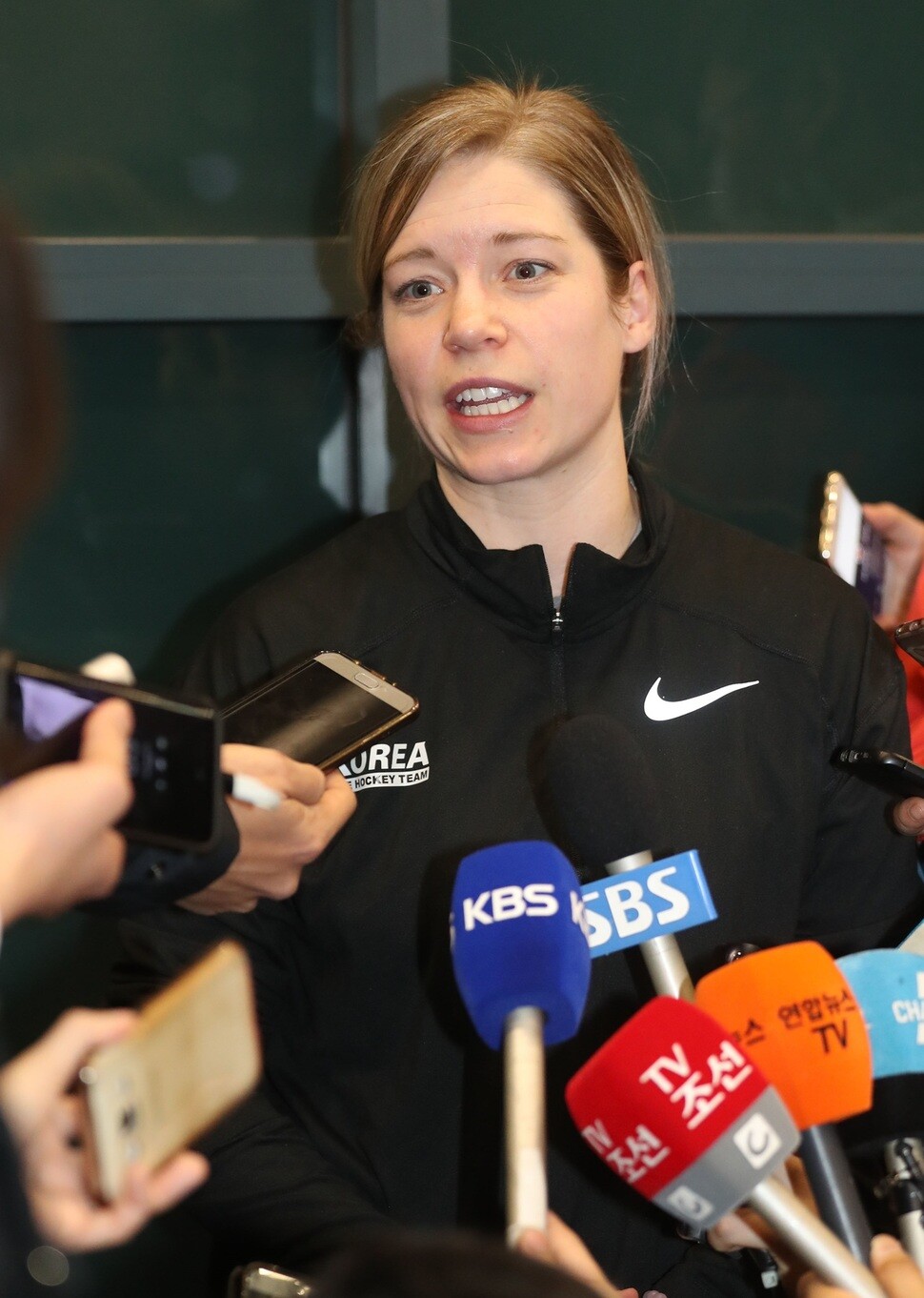hankyoreh
Links to other country sites 다른 나라 사이트 링크
Composition of unified women’s hockey team a product of difficult negotiations

It turns out that it wasn’t easy to reach an agreement about setting up the unified inter-Korean women’s hockey team.
“The composition of the unified women’s hockey team was the hardest part” of the four-party talks between South and North Korea’s Olympic committees, the Pyeongchang Winter Olympics’ organizing committee, and the International Olympic Committee (IOC), South Korean Minister of Culture, Sports and Tourism Do Jong-hwan said during an interview with the press on Jan. 20, following IOC President Thomas Bach’s announcement about the Olympics.
There are supposed to be 23 players on the Olympic roster of the women’s hockey team, with 22 of them allowed to compete in each game. Initially, South Korean officials had predicted that the unified team would include six or so players from the North, which would mean increasing the team roster to 29. The IOC ended up adding 12 North Korean athletes to the original 23 South Koreans, resulting in a roster of 35 athletes, but there was disagreement about how many athletes would play in each game.
“It took a long time to work out the issue of the unified women’s hockey team. The IOC said it wanted five North Korean athletes to play in each game. So we called up the [South] Korea Ice Hockey Association. The coach and association said they could let in three [North Korean players], so ultimately we settled on three [North Koreans playing in each game],” Do said, without confirming whether North Korea had suggested that five of its players could play in each game.
“The International Ice Hockey Federation suggested that all the teams be allowed to field 27 athletes [instead of the 22 listed in the rules] to ensure that five North Korean athletes were on the bench, but the IOC and South Korea did not accept this for reasons of fairness,” Do added.
The International Ice Hockey Federation (IIHF) was willing to bend the normally ironclad rule about roster size because of IIHF President René Fasel’s special interest in the matter. Fasel demonstrated this by personally attending the inter-Korean contest in group A of the IIHF Women’s World Championship Division II, which was held in Gangneung in Apr. 2017, and in taking a photo with players from both teams after the game. There is speculation that Fasel wanted to use a unified inter-Korean team to boost ratings after most of the North American hockey players – some of the world’s best – opted not to participate. Fasel also took appropriate steps to mollify opposition to a unified inter-Korean women’s hockey team voiced by Switzerland and a few other countries.
Other than the issue of the women’s hockey team, it was smooth sailing on the rest of the issues, which were wrapped up in the morning. “The values of mutual understanding, dialogue and peace that the IOC is pursuing were a good fit for the goal we advocated of using the Olympics to build a peaceful and better world. The two North Korean short track athletes were the only addition to North Korea’s contingent at the Pyeongchang Olympics, since we had already discussed the three cross-country skiers, three alpine skiers, two figure skaters and 12 women’s hockey players on the unified team at previous inter-Korean meetings,” Do said.
Challenges ahead for unified hockey team
There are several challenges in store for the first unified Korean women’s hockey team in the history of the Olympics. According to Bach’s Olympic announcement on Jan. 20, the coach supervising the 35 hockey players on the team (that is, the original roster of 23 South Korean players and the additional 12 North Korean players) will be Sarah Murray, 30, the current coach of the South Korean team. It will be up to Murray to decide which 22 players, including 3 North Koreans, will actually compete in each game.
As the team’s coach, Murray should enjoy the freedom to make these decisions without pressure from the outside. There is also a crucial need for cooperation between the South and North Korean hockey associations. “We pretty much know all the North Korean athletes we played against during the world championships in Apr. 2017. We hope that the North will hurry up and send us a list of athletes so we can know which players are coming,” said a spokesperson for the [South] Korea Ice Hockey Association.
“The original agreement was for the North Korean athletes to join training for the unified team on Feb. 1. But since that doesn’t give the athletes enough time to get to know each other, we asked for the North Korean athletes to join training earlier than that,” Do said during his press conference after returning to South Korea on Jan. 21.

By Kim Chang-keum, staff reporter
Please direct questions or comments to [english@hani.co.kr]

Editorial・opinion
![[Column] Season 2 of special prosecutor probe may be coming to Korea soon [Column] Season 2 of special prosecutor probe may be coming to Korea soon](https://flexible.img.hani.co.kr/flexible/normal/500/300/imgdb/original/2024/0426/3317141030699447.jpg) [Column] Season 2 of special prosecutor probe may be coming to Korea soon
[Column] Season 2 of special prosecutor probe may be coming to Korea soon![[Column] Park Geun-hye déjà vu in Yoon Suk-yeol [Column] Park Geun-hye déjà vu in Yoon Suk-yeol](https://flexible.img.hani.co.kr/flexible/normal/500/300/imgdb/original/2024/0424/651713945113788.jpg) [Column] Park Geun-hye déjà vu in Yoon Suk-yeol
[Column] Park Geun-hye déjà vu in Yoon Suk-yeol- [Editorial] New weight of N. Korea’s nuclear threats makes dialogue all the more urgent
- [Guest essay] The real reason Korea’s new right wants to dub Rhee a founding father
- [Column] ‘Choson’: Is it time we start referring to N. Korea in its own terms?
- [Editorial] Japan’s rewriting of history with Korea has gone too far
- [Column] The president’s questionable capacity for dialogue
- [Column] Are chaebol firms just pizza pies for families to divvy up as they please?
- [Column] Has Korea, too, crossed the Rubicon on China?
- [Correspondent’s column] In Japan’s alliance with US, echoes of its past alliances with UK
Most viewed articles
- 1[Column] Season 2 of special prosecutor probe may be coming to Korea soon
- 2‘We must say no’: Seoul defense chief on Korean, USFK involvement in hypothetical Taiwan crisis
- 3Is N. Korea threatening to test nukes in response to possible new US-led sanctions body?
- 4Division commander ordered troops to enter raging flood waters before Marine died, survivor says
- 5Is Japan about to snatch control of Line messenger from Korea’s Naver?
- 6No good, very bad game for Korea puts it out of Olympics for first time since 1988
- 7[Editorial] Korea’s surprise Q1 growth requires objective assessment, not blind fanfare
- 8Korea’s 1.3% growth in Q1 signals ‘textbook’ return to growth, says government
- 9N. Korean delegation’s trip to Iran shows how Pyongyang is leveraging ties with Moscow
- 10Amnesty notes ‘erosion’ of freedom of expression in Korea in annual human rights report